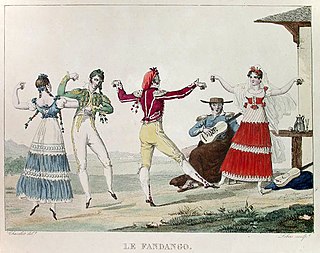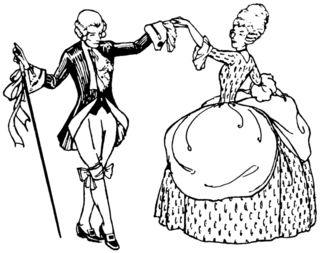 W
WAn allemande is a Renaissance and Baroque dance, and one of the most common instrumental dance styles in Baroque music, with examples by Couperin, Purcell, Bach and Handel. It is often the first movement of a Baroque suite of dances, paired with a subsequent courante, though it is sometimes preceded by an introduction or prelude.
 W
WBall de bastons is the name of a ritual weapon dance spread throughout Europe and the rest of the Iberian area but mostly in Catalonia. English and Welsh Morris dances are well-known relatives to these traditions. The origins of dance are difficult to reference; first recorded mention dates to 1150, in a banquet of Count Berenguer IV)
 W
WThe basse danse, or "low dance", was a popular court dance in the 15th and early 16th centuries, especially at the Burgundian court. The word basse describes the nature of the dance, in which partners move quietly and gracefully in a slow gliding or walking motion without leaving the floor, while in livelier dances both feet left the floor in jumps or leaps. The basse danse was a precursor of the pavane as a dignified processional dance. The term may apply to the dance or the music alone.
 W
WBolero is a Spanish dance in 3/4 time popular in the late 18th and early 19th centuries. It originated from the seguidilla sometime between 1750 and 1772, and it became very popular in Madrid, La Mancha, Andalusia and Murcia in the 1780s. Bolero was performed as a solo or partner dance with a moderately slow tempo, accompanied by guitar and castanets, and with lyrics in the form of the seguidilla.
 W
WThe bourrée is a dance of French origin and the words and music that accompany it. The bourrée resembles the gavotte in that it is in double time and often has a dactylic rhythm. However, it is somewhat quicker, and its phrase starts with a quarter-bar anacrusis or "pick-up", whereas a gavotte has a half-bar anacrusis.
 W
WA branle, also bransle, brangle, brawl, brawle, brall(e), braul(e), brando, bran, or brantle, is a type of French dance popular from the early 16th century to the present, danced by couples in either a line or a circle. The term also refers to the music and the characteristic step of the dance.
 W
WA chaconne is a type of musical composition popular in the baroque era when it was much used as a vehicle for variation on a repeated short harmonic progression, often involving a fairly short repetitive bass-line which offers a compositional outline for variation, decoration, figuration and melodic invention. In this it closely resembles the passacaglia.
 W
WA country dance is any of a very large number of social dances of a type that originated in the British Isles; it is the repeated execution of a predefined sequence of figures, carefully designed to fit a fixed length of music, performed by a group of people, usually in couples, in one or more sets. The figures involve interaction with your partner and/or with other dancers, usually with a progression so that you dance with everyone in your set. It is common in modern times to have a "caller" who teaches the dance and then calls the figures as you dance.
 W
WCsárdás, often seen as Czárdás, is a traditional Hungarian folk dance, the name derived from csárda. It originated in Hungary and was popularized by bands in Hungary and neighboring lands of Slovenia, Burgenland, Croatia, Transylvania, Slovakia and Moravia, as well as among the Banat Bulgarians, including those in Bulgaria.
 W
WFandango is a lively couples dance originating from Portugal and Spain, usually in triple metre, traditionally accompanied by guitars, castanets, or hand-clapping. Fandango can both be sung and danced. Sung fandango is usually bipartite: it has an instrumental introduction followed by "variaciones". Sung fandango usually follows the structure of "cante" that consist of four or five octosyllabic verses (coplas) or musical phrases (tercios). Occasionally, the first copla is repeated.
 W
WThe Farandole is an open-chain community dance popular in Provence, France. The Farandole bears similarities to the gavotte, jig, and tarantella. The carmagnole of the French Revolution is a derivative.
 W
WThe galliard was a form of Renaissance dance and music popular all over Europe in the 16th century. It is mentioned in dance manuals from England, Portugal, France, Spain, Germany, and Italy.
 W
WIn dance, the galop, named after the fastest running gait of a horse, a shortened version of the original term galoppade, is a lively country dance, introduced in the late 1820s to Parisian society by the Duchesse de Berry and popular in Vienna, Berlin and London. In the same closed position familiar in the waltz, the step combined a glissade with a chassé on alternate feet, ordinarily in a fast 24 time.
 W
WThe gavotte is a French dance, taking its name from a folk dance of the Gavot, the people of the Pays de Gap region of Dauphiné in the southeast of France, where the dance originated, according to one source. According to another reference, however, the word "gavotte" is a generic term for a variety of French folk dances, and most likely originated in Lower Brittany in the west, or possibly Provence in the southeast or the French Basque Country in the southwest of France. It is notated in 44 or 22 time and is usually of moderate tempo, though the folk dances also use meters such as 98 and 58.
 W
WHopak is a Ukrainian folk dance originating as a male dance among the Zaporozhian Cossacks but, later danced by couples, male soloists, and mixed groups of dancers. It is performed most often as a solitary concert dance by amateur and professional Ukrainian dance ensembles, as well as other performers of folk dances. It has also been incorporated into larger artistic opuses such as operas, ballets and theatre.
 W
WThe hornpipe is any of several dance forms played and danced in Britain and Ireland and elsewhere from the 16th century until the present day. The earliest references to hornpipes are from England with Hugh Aston's Hornepype of 1522 and others referring to Lancashire hornpipes in 1609 and 1613.
 W
WThe jota is a genre of music and the associated dance known throughout Spain, most likely originating in Aragon. It varies by region, having a characteristic form in Aragon, Catalonia, Castile, Navarre, Cantabria, Asturias, Galicia, La Rioja, Murcia and Eastern Andalusia. Being a visual representation, the jota is danced and sung accompanied by castanets, and the interpreters tend to wear regional costumes. In Valencia, the jota was once danced during interment ceremonies.
 W
WIn Southeastern Europe, the Serbian traditionally dance the circle dance, known as kolo, named after the circle formed by the dancers.
 W
WThe Krakowiak or Cracovienne is a fast, syncopated Polish folk dance in duple time from the region of Kraków and Lesser Poland. The folk outfit worn for the dance has become the national costume of Poland, most notably, the rogatywka peaked hat with peacock feathers.
 W
WThe Ländler is a folk dance in 34 time which was popular in Austria, Bavaria, German Switzerland, and Slovenia at the end of the 18th century.
 W
WA minuet is a social dance of French origin for two people, usually in 34 time. The English word was adapted from the Italian minuetto and the French menuet.
 W
WPasodoble is a fast-paced Spanish military march used by infantry troops. Its speed allowed troops to give 120 steps per minute. This march gave rise to a traditional Spanish dance, a musical genre including both voice and instruments, and a genre of instrumental music often played during bullfight. Both the dance and the non martial compositions are also called pasodoble.
 W
WThe passepied is a French court dance. Originating as a kind of Breton branle, it was adapted to courtly use in the 16th century and is found frequently in 18th-century French opera and ballet, particularly in pastoral scenes, and latterly also in baroque instrumental suites of dances. In English the passepied has been spelled "paspy" as well as "paspie" or "paspe", phonetic approximations of the French pronunciation.
 W
WThe pavane is a slow processional dance common in Europe during the 16th century (Renaissance).
 W
WThe polonaise is a dance of Polish origin, in 34 time. Its name is French for "Polish".
 W
WThe quadrille is a dance that was fashionable in late 18th- and 19th-century Europe and its colonies. The quadrille consists of a chain of four to six contredanses. Latterly the quadrille was frequently danced to a medley of opera melodies.
 W
WThe rigaudon is a French baroque dance with a lively duple metre. The music is similar to that of a bourrée, but the rigaudon is rhythmically simpler with regular phrases. It originated as a sprightly 17th-century French folk dance for couples. Traditionally, the folkdance was associated with the provinces of Vavarais, Languedoc, Dauphiné, and Provence in southern France, and it became popular as a court dance during the reign of Louis XIV. Its hopping steps were adopted by the skillful dancers of the French and English courts, where it remained fashionable through the 18th century. By the close of the 18th century, however, it had given way in popularity as a ballroom dance to the minuet.
 W
WThe saltarello is a musical dance originally from Italy. The first mention of it is in Add MS 29987, a late-fourteenth- or early fifteenth-century manuscript of Tuscan origin, now in the British Library. It was usually played in a fast triple meter and is named for its peculiar leaping step, after the Italian verb saltare. This characteristic is also the basis of the German name Hoppertanz or Hupfertanz ; other names include the French pas de Brabant and the Spanish alta or alta danza.
 W
WThe sarabande is a dance in triple metre, or the music written for such a dance.
 W
WThe seguidilla is an old Castilian folksong and dance form in quick triple time for two people with many regional variations. The music is generally in a major key and often begins on an offbeat.
 W
WSkočná is a rapid Slavic folk-dance, normally in 24 metre. Czech composers Antonín Dvořák and Bedřich Smetana used this dance, the latter in the third act of The Bartered Bride where it is danced by a circus troupe and is often known as the Dance of the Comedians. Dvořák's 5th, 7th and 11th Slavonic Dances are in the form of the skočná.